Financial Analysis and Performance Comparison: Santos Ltd and Woodside
VerifiedAdded on 2022/12/23
|9
|1786
|4
Report
AI Summary
This report provides a comprehensive financial analysis comparing the performance of Santos Ltd and Woodside Petroleum. It begins with an introduction to both companies, highlighting their core activities and market positions. The analysis then delves into key financial aspects, including sales and production volume growth, income statement trends, and a detailed examination of key ratios such as the cash conversion cycle, profitability ratios (gross profit margin), liquidity ratios (current ratio), and financial leverage (long-term interest-bearing loan to equity, interest coverage ratio). The report utilizes horizontal (key trend) analysis and ratio analysis to evaluate the companies' financial health, efficiency, and risk profile over the period from 2016 to 2020, providing insights into their respective strengths and weaknesses and the impact of external factors like the COVID-19 pandemic. The report also includes a comparative assessment of dividend payout ratios and provides context for the financial data, discussing management strategies and external influences on performance.

ACCOUNTING FOR
MANAGERS
MANAGERS
Paraphrase This Document
Need a fresh take? Get an instant paraphrase of this document with our AI Paraphraser
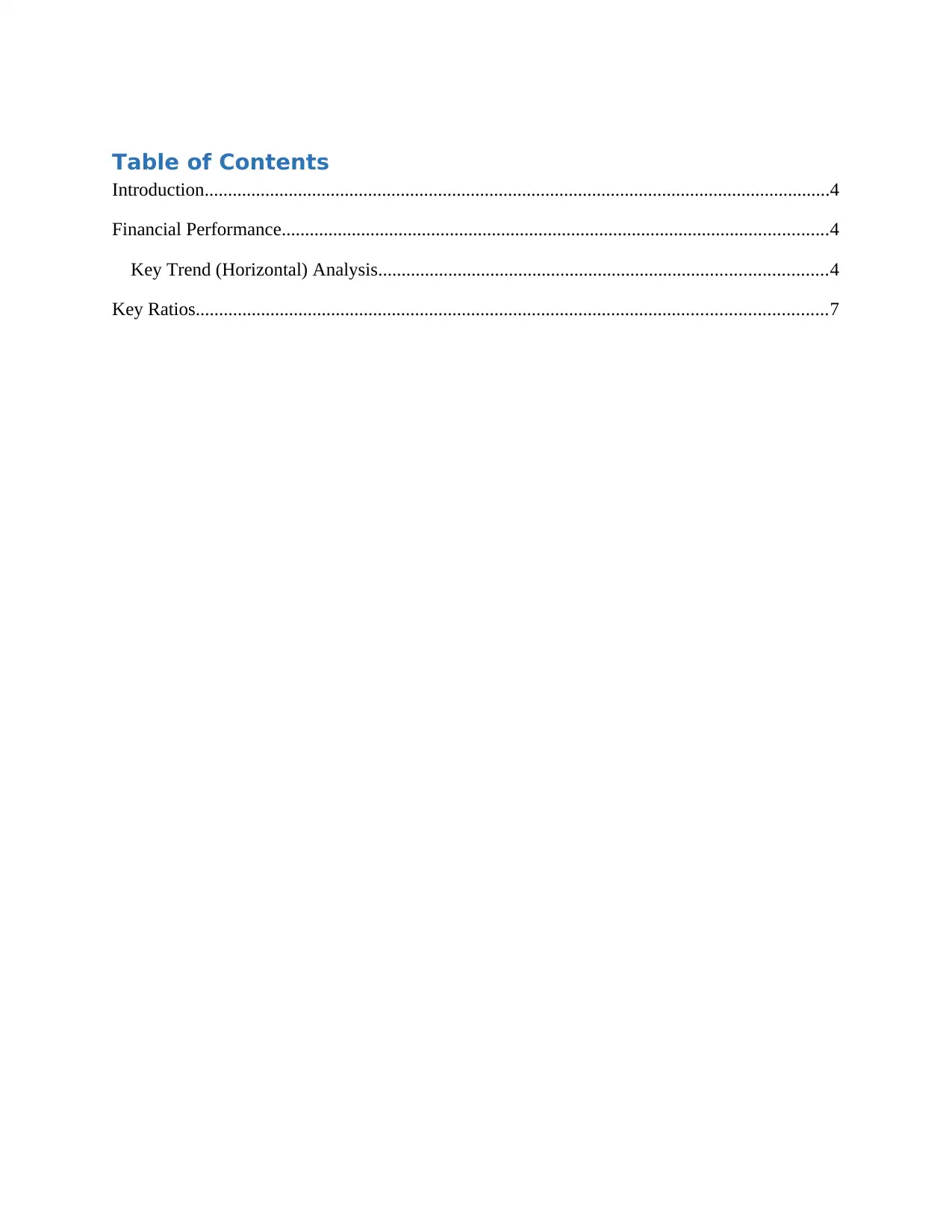
Table of Contents
Introduction......................................................................................................................................4
Financial Performance.....................................................................................................................4
Key Trend (Horizontal) Analysis................................................................................................4
Key Ratios.......................................................................................................................................7
Introduction......................................................................................................................................4
Financial Performance.....................................................................................................................4
Key Trend (Horizontal) Analysis................................................................................................4
Key Ratios.......................................................................................................................................7

Introduction
Santos Limited was liquidated and registered on the Australian stock market in 1954 under the
code STO. Santos is an Australian group, based in Adelaide, South Australia. Its core activities
include the exploration, supply and supply of oil and gas for the energy needs of national,
industrial and key companies in Australia and Asia. It has five long-lived gaseous gasoline
sources which are GLNG, PNG LNG. Santos' operations are primarily concentrated in Australia
and Asia Pacific and have a 1900 workforce. Santos is recognized as a key player in rural gas
suppliers and LNG exporters (Santos Publishers, 2020).
In evaluating Santos 'proven performance and prospects for future executions, Woodside
Petroleum Ltd was selected as Santos' inspiring benchmark. Woodside Petroleum is also an
Australian group and has settled in Perth, Western Australia. The company was founded in 1954
and was once known as Woodside Oil NL. In 1971, the company was confirmed as Woodside
Petroleum Limited "Woodside" and registered on the Australian Stock Exchange under the code
WPL. Unlike Santos, Woodside's business line includes the exploration, creation and supply of
oil and gas for energy needs. Additionally, Woodside is recognized as one of Australia's leading
national gas suppliers and largest gasoline producer. Woodside has a production force of over
3,600, a larger worldwide presence, and nearly double the size of the piece facing Santos.
Financial Performance
The implementation of Santos currency will be halted by the use of cash proceeds in the last few
years (2016 to 2020). Methods of analysis include pattern (uniform) analysis, “SGR” growth
rate, the compilation of working capital calculations including the cash turnover cycle and other
key allowances for further analysis. Santos benefits, liquidity and cash risk. The forest side will
be used as a benchmark to study Santos' silver value. Despite the fact that Woodside is larger and
more complex in terms of market size and total assets, strategies for using the pattern (uniform)
and proportion analysis (vertical) will help make a budget summary of a consistent size to allow
for a similar analysis between two distinct group dimensions.
Santos Limited was liquidated and registered on the Australian stock market in 1954 under the
code STO. Santos is an Australian group, based in Adelaide, South Australia. Its core activities
include the exploration, supply and supply of oil and gas for the energy needs of national,
industrial and key companies in Australia and Asia. It has five long-lived gaseous gasoline
sources which are GLNG, PNG LNG. Santos' operations are primarily concentrated in Australia
and Asia Pacific and have a 1900 workforce. Santos is recognized as a key player in rural gas
suppliers and LNG exporters (Santos Publishers, 2020).
In evaluating Santos 'proven performance and prospects for future executions, Woodside
Petroleum Ltd was selected as Santos' inspiring benchmark. Woodside Petroleum is also an
Australian group and has settled in Perth, Western Australia. The company was founded in 1954
and was once known as Woodside Oil NL. In 1971, the company was confirmed as Woodside
Petroleum Limited "Woodside" and registered on the Australian Stock Exchange under the code
WPL. Unlike Santos, Woodside's business line includes the exploration, creation and supply of
oil and gas for energy needs. Additionally, Woodside is recognized as one of Australia's leading
national gas suppliers and largest gasoline producer. Woodside has a production force of over
3,600, a larger worldwide presence, and nearly double the size of the piece facing Santos.
Financial Performance
The implementation of Santos currency will be halted by the use of cash proceeds in the last few
years (2016 to 2020). Methods of analysis include pattern (uniform) analysis, “SGR” growth
rate, the compilation of working capital calculations including the cash turnover cycle and other
key allowances for further analysis. Santos benefits, liquidity and cash risk. The forest side will
be used as a benchmark to study Santos' silver value. Despite the fact that Woodside is larger and
more complex in terms of market size and total assets, strategies for using the pattern (uniform)
and proportion analysis (vertical) will help make a budget summary of a consistent size to allow
for a similar analysis between two distinct group dimensions.
⊘ This is a preview!⊘
Do you want full access?
Subscribe today to unlock all pages.

Trusted by 1+ million students worldwide
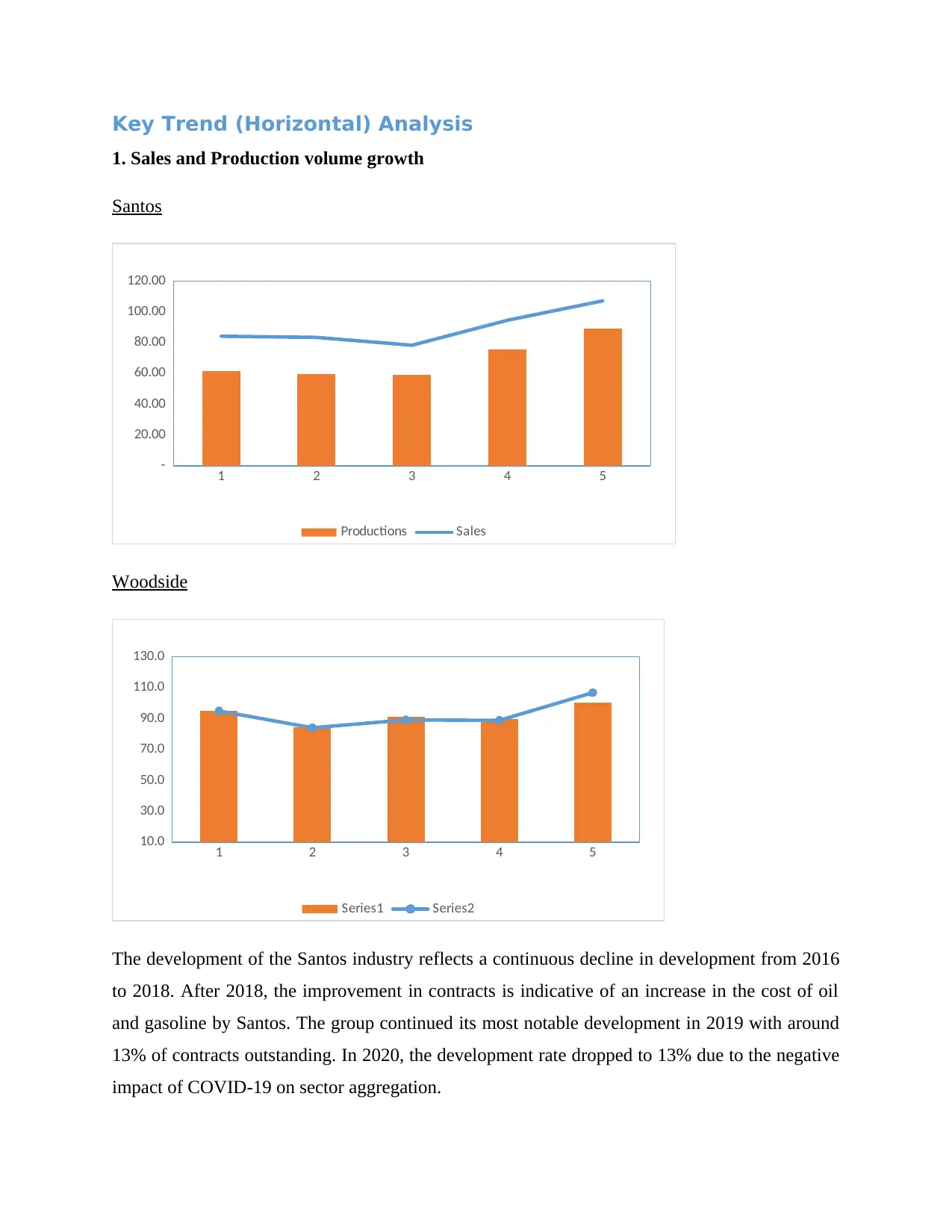
Key Trend (Horizontal) Analysis
1. Sales and Production volume growth
Santos
1 2 3 4 5
-
20.00
40.00
60.00
80.00
100.00
120.00
Productions Sales
Woodside
1 2 3 4 5
10.0
30.0
50.0
70.0
90.0
110.0
130.0
Series1 Series2
The development of the Santos industry reflects a continuous decline in development from 2016
to 2018. After 2018, the improvement in contracts is indicative of an increase in the cost of oil
and gasoline by Santos. The group continued its most notable development in 2019 with around
13% of contracts outstanding. In 2020, the development rate dropped to 13% due to the negative
impact of COVID-19 on sector aggregation.
1. Sales and Production volume growth
Santos
1 2 3 4 5
-
20.00
40.00
60.00
80.00
100.00
120.00
Productions Sales
Woodside
1 2 3 4 5
10.0
30.0
50.0
70.0
90.0
110.0
130.0
Series1 Series2
The development of the Santos industry reflects a continuous decline in development from 2016
to 2018. After 2018, the improvement in contracts is indicative of an increase in the cost of oil
and gasoline by Santos. The group continued its most notable development in 2019 with around
13% of contracts outstanding. In 2020, the development rate dropped to 13% due to the negative
impact of COVID-19 on sector aggregation.
Paraphrase This Document
Need a fresh take? Get an instant paraphrase of this document with our AI Paraphraser
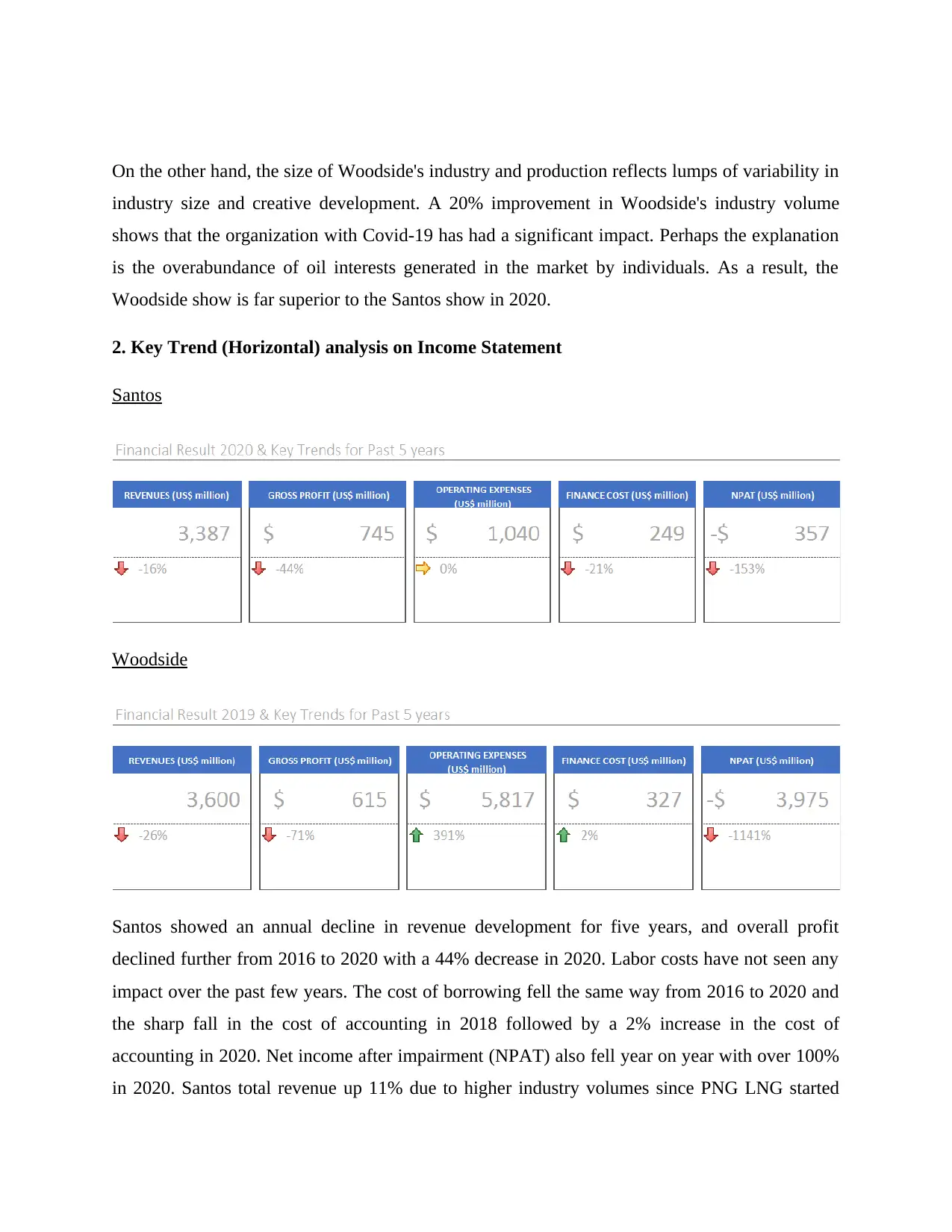
On the other hand, the size of Woodside's industry and production reflects lumps of variability in
industry size and creative development. A 20% improvement in Woodside's industry volume
shows that the organization with Covid-19 has had a significant impact. Perhaps the explanation
is the overabundance of oil interests generated in the market by individuals. As a result, the
Woodside show is far superior to the Santos show in 2020.
2. Key Trend (Horizontal) analysis on Income Statement
Santos
Woodside
Santos showed an annual decline in revenue development for five years, and overall profit
declined further from 2016 to 2020 with a 44% decrease in 2020. Labor costs have not seen any
impact over the past few years. The cost of borrowing fell the same way from 2016 to 2020 and
the sharp fall in the cost of accounting in 2018 followed by a 2% increase in the cost of
accounting in 2020. Net income after impairment (NPAT) also fell year on year with over 100%
in 2020. Santos total revenue up 11% due to higher industry volumes since PNG LNG started
industry size and creative development. A 20% improvement in Woodside's industry volume
shows that the organization with Covid-19 has had a significant impact. Perhaps the explanation
is the overabundance of oil interests generated in the market by individuals. As a result, the
Woodside show is far superior to the Santos show in 2020.
2. Key Trend (Horizontal) analysis on Income Statement
Santos
Woodside
Santos showed an annual decline in revenue development for five years, and overall profit
declined further from 2016 to 2020 with a 44% decrease in 2020. Labor costs have not seen any
impact over the past few years. The cost of borrowing fell the same way from 2016 to 2020 and
the sharp fall in the cost of accounting in 2018 followed by a 2% increase in the cost of
accounting in 2020. Net income after impairment (NPAT) also fell year on year with over 100%
in 2020. Santos total revenue up 11% due to higher industry volumes since PNG LNG started

full formation after the 1H18 earthquake and higher volumes of gas as a result of Quadrant
Energy cooling offset by lower item costs. The average known cost of oil fell 4% to $ 71.99 /
barrel and the average known cost of LNG fell 1% to $ 9.77 / mmBtu. Moreover, in 2020,
trading revenue increased 10% to $ 4 billion; the average known cost of oil fell 4% to $ 71.99 /
barrel. Santos ’big skins in Western Australia and Basin Cooper won a strong benchmark award.
In addition, Woodside showed a decrease in revenue from 2015 to 2017, followed by a strong
expansion in 2018 and a decrease of 7% in 2019. Full benefit follows the development of the
revenue model -in, however with a sharper decline in net revenue of 19% in 2019. Woodside was
broadcasting a full-year production of 100.3 million barrels of oil itself and making the most safe
run. best ever despite difficult external conditions in 2020. Labor spending showed a decline
from 2016 to 2018 and is still declining due to the impact of Covid -19 on the group. There is
also an extension model for the Woodside account cost. Because of this weakness, NPAT
Woodside decreased 25% in 2020 compared to 2019.
From studying the model, Santos has extended a more controlled and progressive term in terms
of income and welfare development, while continuing to operate at a lower year-over-year cost
than Woodside. Hosting to create contracts from the third purchase comes along with the Santos
Highlands to develop contracts beyond the normal creation limit.
Key Ratios
Cash Conversion Cycle
The cash conversion cycle is used to measure the working capital productivity of an
organization. This is the amount of time an organization can quickly convert to cash available
from the sale of shares and from raising money from credit as a trade to paying off debt. Below
is the proportion of Santos's relationship with Woodside in the currency exchange cycle:
Cash Conversion Cycle
2017 2018 2019 2020
Trade Receivables Turnover (Days) 28 35 35 32
Inventory Turnover (Days) 25 47 43
Energy cooling offset by lower item costs. The average known cost of oil fell 4% to $ 71.99 /
barrel and the average known cost of LNG fell 1% to $ 9.77 / mmBtu. Moreover, in 2020,
trading revenue increased 10% to $ 4 billion; the average known cost of oil fell 4% to $ 71.99 /
barrel. Santos ’big skins in Western Australia and Basin Cooper won a strong benchmark award.
In addition, Woodside showed a decrease in revenue from 2015 to 2017, followed by a strong
expansion in 2018 and a decrease of 7% in 2019. Full benefit follows the development of the
revenue model -in, however with a sharper decline in net revenue of 19% in 2019. Woodside was
broadcasting a full-year production of 100.3 million barrels of oil itself and making the most safe
run. best ever despite difficult external conditions in 2020. Labor spending showed a decline
from 2016 to 2018 and is still declining due to the impact of Covid -19 on the group. There is
also an extension model for the Woodside account cost. Because of this weakness, NPAT
Woodside decreased 25% in 2020 compared to 2019.
From studying the model, Santos has extended a more controlled and progressive term in terms
of income and welfare development, while continuing to operate at a lower year-over-year cost
than Woodside. Hosting to create contracts from the third purchase comes along with the Santos
Highlands to develop contracts beyond the normal creation limit.
Key Ratios
Cash Conversion Cycle
The cash conversion cycle is used to measure the working capital productivity of an
organization. This is the amount of time an organization can quickly convert to cash available
from the sale of shares and from raising money from credit as a trade to paying off debt. Below
is the proportion of Santos's relationship with Woodside in the currency exchange cycle:
Cash Conversion Cycle
2017 2018 2019 2020
Trade Receivables Turnover (Days) 28 35 35 32
Inventory Turnover (Days) 25 47 43
⊘ This is a preview!⊘
Do you want full access?
Subscribe today to unlock all pages.

Trusted by 1+ million students worldwide
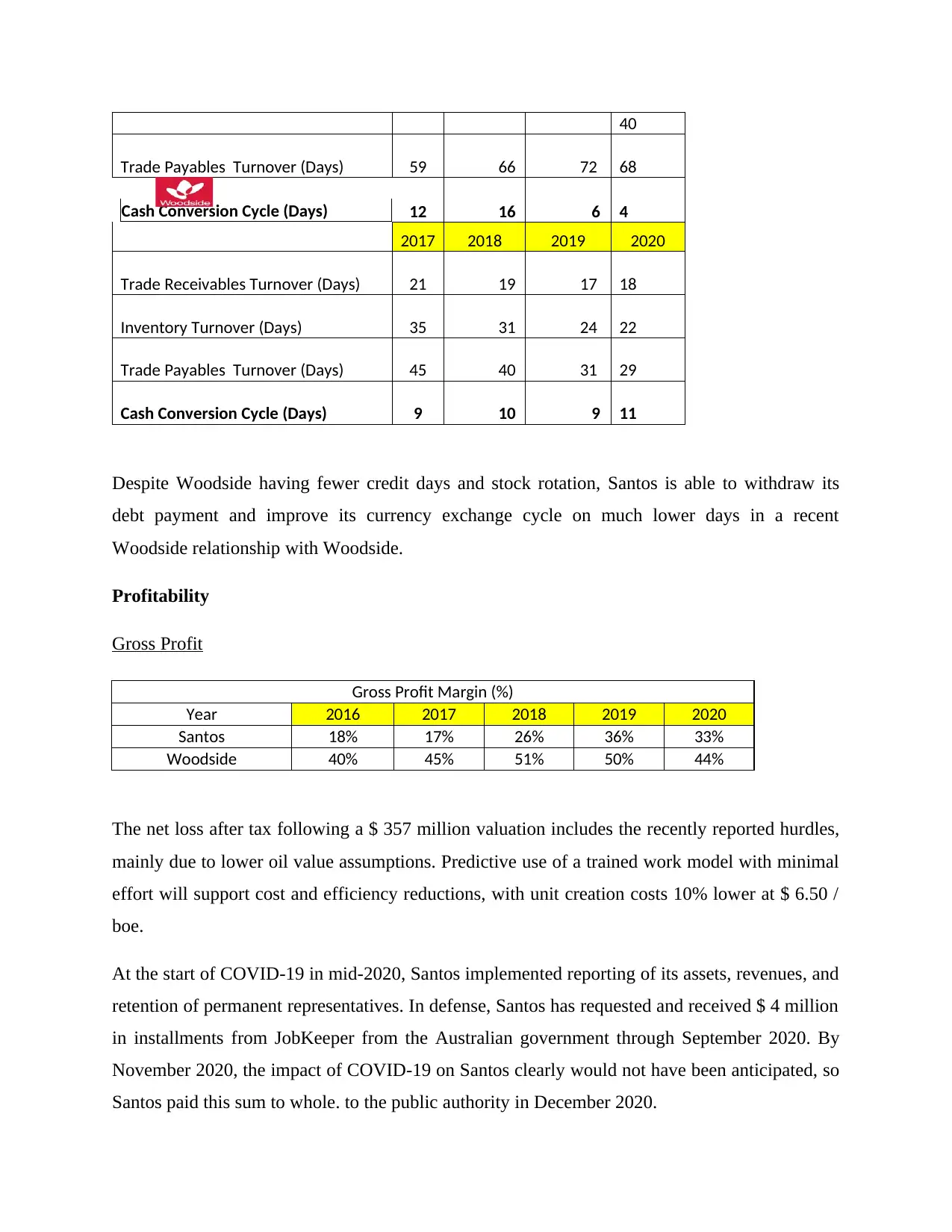
40
Trade Payables Turnover (Days) 59 66 72 68
Cash Conversion Cycle (Days) 12 16 6 4
2017 2018 2019 2020
Trade Receivables Turnover (Days) 21 19 17 18
Inventory Turnover (Days) 35 31 24 22
Trade Payables Turnover (Days) 45 40 31 29
Cash Conversion Cycle (Days) 9 10 9 11
Despite Woodside having fewer credit days and stock rotation, Santos is able to withdraw its
debt payment and improve its currency exchange cycle on much lower days in a recent
Woodside relationship with Woodside.
Profitability
Gross Profit
Gross Profit Margin (%)
Year 2016 2017 2018 2019 2020
Santos 18% 17% 26% 36% 33%
Woodside 40% 45% 51% 50% 44%
The net loss after tax following a $ 357 million valuation includes the recently reported hurdles,
mainly due to lower oil value assumptions. Predictive use of a trained work model with minimal
effort will support cost and efficiency reductions, with unit creation costs 10% lower at $ 6.50 /
boe.
At the start of COVID-19 in mid-2020, Santos implemented reporting of its assets, revenues, and
retention of permanent representatives. In defense, Santos has requested and received $ 4 million
in installments from JobKeeper from the Australian government through September 2020. By
November 2020, the impact of COVID-19 on Santos clearly would not have been anticipated, so
Santos paid this sum to whole. to the public authority in December 2020.
Trade Payables Turnover (Days) 59 66 72 68
Cash Conversion Cycle (Days) 12 16 6 4
2017 2018 2019 2020
Trade Receivables Turnover (Days) 21 19 17 18
Inventory Turnover (Days) 35 31 24 22
Trade Payables Turnover (Days) 45 40 31 29
Cash Conversion Cycle (Days) 9 10 9 11
Despite Woodside having fewer credit days and stock rotation, Santos is able to withdraw its
debt payment and improve its currency exchange cycle on much lower days in a recent
Woodside relationship with Woodside.
Profitability
Gross Profit
Gross Profit Margin (%)
Year 2016 2017 2018 2019 2020
Santos 18% 17% 26% 36% 33%
Woodside 40% 45% 51% 50% 44%
The net loss after tax following a $ 357 million valuation includes the recently reported hurdles,
mainly due to lower oil value assumptions. Predictive use of a trained work model with minimal
effort will support cost and efficiency reductions, with unit creation costs 10% lower at $ 6.50 /
boe.
At the start of COVID-19 in mid-2020, Santos implemented reporting of its assets, revenues, and
retention of permanent representatives. In defense, Santos has requested and received $ 4 million
in installments from JobKeeper from the Australian government through September 2020. By
November 2020, the impact of COVID-19 on Santos clearly would not have been anticipated, so
Santos paid this sum to whole. to the public authority in December 2020.
Paraphrase This Document
Need a fresh take? Get an instant paraphrase of this document with our AI Paraphraser

Woodside has an overall net deficit after cost of $ 4.028 million, and was impacted by non-
monetary weaknesses and the termination of charges agreements reported in July 2020. A
supported operating major provided hidden net gain after cost. (NPAT) of USD 447 million.
Dividend Payout ratio
Dividend Payout ratio
Year 2016 2017 2018 2019 2020
Santos 1% 0% 0% 32% 34%
Woodside 60% 72% 71% 92% 224%
The Board expects to fully deliver a final profit of US5.0 cents per share, based on the previous
year's previous profit. This will bring full year profits to 7.1 cents for each full stamp allowance,
covering 20% of free income and in line with the organization's operating profit strategy which
aims for a range of 10% to 30% payment of free income.
Woodside bosses reported a final profit of 12 cps per offer (cps), bringing the full-year profit to
38 cps. Profit depended on the NPAT base of $ 447 million.
Liquidity
Current Ratio
Current Ratio: Current Asset: Current Liabilities
Year 2016 2017 2018 2019 2020
Santos 1.10 1.90 2.07 1.20 1.65
Woodside 0.95 0.93 0.97 2.31 4.11
Santos has managed to keep their current ratio above 1 over the past five years while Woodside
has improved their liquidity position from below 1 to 4.11 in 2020. Woodside do have huge cash
on hand.
Financial Leverage
1. Long term interest-bearing loan: Equity
monetary weaknesses and the termination of charges agreements reported in July 2020. A
supported operating major provided hidden net gain after cost. (NPAT) of USD 447 million.
Dividend Payout ratio
Dividend Payout ratio
Year 2016 2017 2018 2019 2020
Santos 1% 0% 0% 32% 34%
Woodside 60% 72% 71% 92% 224%
The Board expects to fully deliver a final profit of US5.0 cents per share, based on the previous
year's previous profit. This will bring full year profits to 7.1 cents for each full stamp allowance,
covering 20% of free income and in line with the organization's operating profit strategy which
aims for a range of 10% to 30% payment of free income.
Woodside bosses reported a final profit of 12 cps per offer (cps), bringing the full-year profit to
38 cps. Profit depended on the NPAT base of $ 447 million.
Liquidity
Current Ratio
Current Ratio: Current Asset: Current Liabilities
Year 2016 2017 2018 2019 2020
Santos 1.10 1.90 2.07 1.20 1.65
Woodside 0.95 0.93 0.97 2.31 4.11
Santos has managed to keep their current ratio above 1 over the past five years while Woodside
has improved their liquidity position from below 1 to 4.11 in 2020. Woodside do have huge cash
on hand.
Financial Leverage
1. Long term interest-bearing loan: Equity
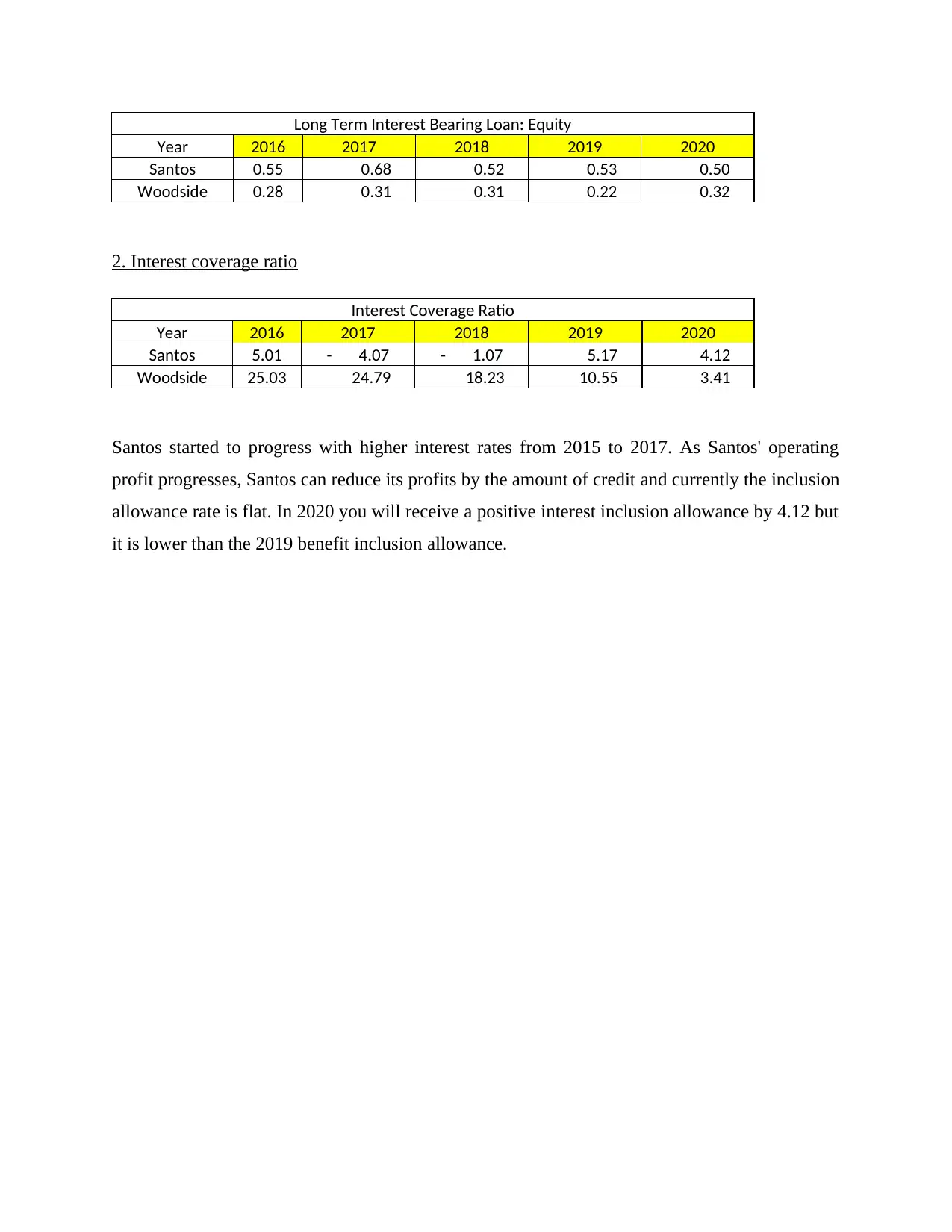
Long Term Interest Bearing Loan: Equity
Year 2016 2017 2018 2019 2020
Santos 0.55 0.68 0.52 0.53 0.50
Woodside 0.28 0.31 0.31 0.22 0.32
2. Interest coverage ratio
Interest Coverage Ratio
Year 2016 2017 2018 2019 2020
Santos 5.01 - 4.07 - 1.07 5.17 4.12
Woodside 25.03 24.79 18.23 10.55 3.41
Santos started to progress with higher interest rates from 2015 to 2017. As Santos' operating
profit progresses, Santos can reduce its profits by the amount of credit and currently the inclusion
allowance rate is flat. In 2020 you will receive a positive interest inclusion allowance by 4.12 but
it is lower than the 2019 benefit inclusion allowance.
Year 2016 2017 2018 2019 2020
Santos 0.55 0.68 0.52 0.53 0.50
Woodside 0.28 0.31 0.31 0.22 0.32
2. Interest coverage ratio
Interest Coverage Ratio
Year 2016 2017 2018 2019 2020
Santos 5.01 - 4.07 - 1.07 5.17 4.12
Woodside 25.03 24.79 18.23 10.55 3.41
Santos started to progress with higher interest rates from 2015 to 2017. As Santos' operating
profit progresses, Santos can reduce its profits by the amount of credit and currently the inclusion
allowance rate is flat. In 2020 you will receive a positive interest inclusion allowance by 4.12 but
it is lower than the 2019 benefit inclusion allowance.
⊘ This is a preview!⊘
Do you want full access?
Subscribe today to unlock all pages.

Trusted by 1+ million students worldwide
1 out of 9
Related Documents
Your All-in-One AI-Powered Toolkit for Academic Success.
+13062052269
info@desklib.com
Available 24*7 on WhatsApp / Email
![[object Object]](/_next/static/media/star-bottom.7253800d.svg)
Unlock your academic potential
Copyright © 2020–2025 A2Z Services. All Rights Reserved. Developed and managed by ZUCOL.





